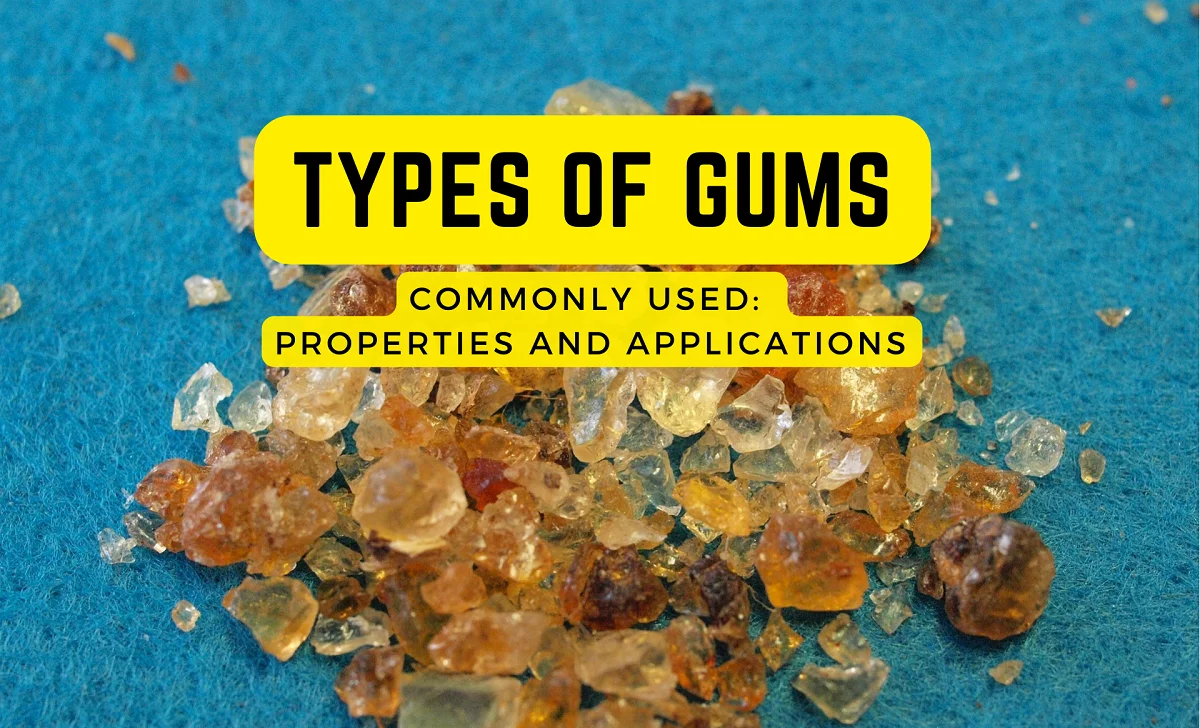Types of Gums Commonly Used: Gums are a vital ingredient in the food, pharmaceutical, and cosmetic industries. They are natural polymers that enhance the texture, stability, and sensory properties of food products. In this article, we will discuss the most commonly used gums in the industry and their properties. Gums are a group of hydrocolloids that are widely used in the food, pharmaceutical, and cosmetic industries. They are polysaccharides that can form gels or viscosities when mixed with water or other liquids. Gums are used to improve the texture, consistency, and stability of products.
Gums in The Food industry
In the food industry, gums are used in a variety of products such as sauces, dressings, bakery goods, confectionery, dairy products, and meat products. They can be used to thicken, stabilize, emulsify, and bind ingredients, as well as to prevent crystallization and extend shelf life. Gums can also be used in low-fat or low-sugar products to improve the texture and mouthfeel.
Gums in The Pharmaceutical industry
In the pharmaceutical industry, gums are used as binders, disintegrants, and sustained-release agents in tablets and capsules. They can also be used to improve the viscosity and flow properties of liquid formulations.
Gums in The Cosmetic industry
In the cosmetic industry, gums are used as thickeners, emulsifiers, and stabilizers in lotions, creams, shampoos, and other personal care products. They can also be used to improve the texture and spreadability of products.
The importance of gums in these industries cannot be overstated. Gums are essential for achieving the desired properties of products, such as texture, viscosity, and stability. Without gums, many products would not be able to be produced in a consistent and desirable manner.
Types of Gums
1. Xanthan Gum
Xanthan gum is a high molecular weight polysaccharide produced by the bacterium Xanthomonas campestris. It is widely used in the food industry as a thickener, stabilizer, and emulsifier. It is also used in the pharmaceutical and cosmetic industries. Xanthan gum is highly soluble in cold water and can form stable gels at low concentrations.
2. Guar Gum
Guar gum is a galactomannan polysaccharide extracted from the seeds of the guar plant. It is widely used in the food industry as a thickener, stabilizer, and emulsifier. Guar gum is highly soluble in cold water and can form stable gels at low concentrations. It is also used in the pharmaceutical and cosmetic industries.
3. Gum Arabic
Gum arabic is a natural gum exudate obtained from the stems and branches of Acacia Senegal and Acacia seyal trees. It is widely used in the food industry as a stabilizer, emulsifier, and thickener. Gum arabic is highly soluble in water and can form stable gels at low concentrations. It is also used in the pharmaceutical and cosmetic industries.
4. Carrageenan
Carrageenan is a family of linear sulfated polysaccharides extracted from red seaweeds. It is widely used in the food industry as a thickener, stabilizer, and emulsifier. Carrageenan can form stable gels at low concentrations and is highly soluble in water. It is also used in the pharmaceutical and cosmetic industries.
5. Locust Bean Gum (Carob Gum)
Locust bean gum, also known as carob gum, is a galactomannan polysaccharide extracted from the seeds of the carob tree. It is widely used in the food industry as a thickener, stabilizer, and emulsifier. Locust bean gum is highly soluble in water and can form stable gels at low concentrations. It is also used in the pharmaceutical and cosmetic industries.
6. Agar
Agar is a polysaccharide derived from seaweed. It is widely used in the food industry as a gelling agent, thickener, and stabilizer. Agar can form strong gels at low concentrations and is highly soluble in hot water. It is also used in the pharmaceutical and cosmetic industries.
7. Gellan Gum
Gellan gum is a high molecular weight polysaccharide produced by the bacterium Sphingomonas elodea. It is widely used in the food industry as a gelling agent, thickener, and stabilizer. Gellan gum can form strong gels at low concentrations and is highly soluble in hot water. It is also used in the pharmaceutical and cosmetic industries.
8. Tara Gum
Tara gum is a galactomannan polysaccharide extracted from the seeds of the tara tree. It is widely used in the food industry as a thickener, stabilizer, and emulsifier. Tara gum is highly soluble in water and can form stable gels at low concentrations. It is also used in the pharmaceutical and cosmetic industries.
9. Arabic Gum
Arabic gum is a natural exudate obtained from the stems and branches of Acacia Senegal and Acacia seyal trees. It is widely used in the food industry as a stabilizer, emulsifier, and thickener. Arabic gum is highly soluble in water and can form stable gels at low concentrations. It is also used in the pharmaceutical and cosmetic industries.
10. Konjac Gum (Glucomannan)
Konjac gum, also known as glucomannan, is a polysaccharide derived from the root of the konjac plant. It is widely used in the food industry as a thickener, stabilizer, and gelling agent. Konjac gum is highly soluble in water and can form stable gels at low concentrations. It is also used in the pharmaceutical and cosmetic industries.
11. Tragacanth Gum
Tragacanth gum is a natural gum exudate obtained from the stems and branches of the Astragalus plant. It is widely used in the food industry as a thickener, stabilizer, and emulsifier. Tragacanth gum is highly soluble in water and can form stable gels at low concentrations. It is also used in the pharmaceutical and cosmetic industries.
12. Cellulose Gum (CMC)
Cellulose gum, also known as carboxymethyl cellulose (CMC), is a cellulose derivative. It is widely used in the food industry as a thickener, stabilizer, and emulsifier. Cellulose gum is highly soluble in water and can form stable gels at low concentrations. It is also used in the pharmaceutical and cosmetic industries.
13. Pectin
Pectin is a natural polysaccharide found in the cell walls of plants. It is widely used in the food industry as a gelling agent, thickener, and stabilizer. Pectin can form strong gels at low concentrations and is highly soluble in hot water. It is also used in the pharmaceutical and cosmetic industries.
14. Xanthan Gum
Xanthan gum is a polysaccharide produced by the bacterium Xanthomonas campestris. It is widely used in the food industry as a thickener, stabilizer, and emulsifier. Xanthan gum can form strong gels at low concentrations and is highly soluble in water. It is also used in the pharmaceutical and cosmetic industries.
15. Guar Gum
Guar gum is a galactomannan polysaccharide extracted from the seeds of the guar plant. It is widely used in the food industry as a thickener, stabilizer, and emulsifier. Guar gum is highly soluble in water and can form stable gels at low concentrations. It is also used in the pharmaceutical and cosmetic industries.
Overall, these are the most commonly used types of gums in the food, pharmaceutical, and cosmetic industries. They each have unique properties and uses, but they all serve the common purpose of improving the texture, consistency, and stability of products.
In summary, gums play a vital role in the production of various food, pharmaceutical, and cosmetic products. They are essential for achieving the desired texture, consistency, and stability of products. With the wide variety of gums available, manufacturers have the flexibility to choose the most suitable option for their specific product needs. As the demand for natural and functional ingredients continues to grow, gums will continue to play an increasingly important role in the food, pharmaceutical, and cosmetic industries.
FAQs
- Are gums safe to consume? Yes, gums are generally recognized as safe (GRAS) by regulatory agencies such as the US Food and Drug Administration (FDA) and the European Food Safety Authority (EFSA). However, some people may have allergies or intolerances to certain types of gums.
- Can gums be used in vegan products? Yes, many types of gums are plant-based and can be used in vegan products.
- Are gums natural ingredients? Some types of gums, such as agar, carrageenan, and konjac gum, are derived from natural sources. Others, such as xanthan gum and cellulose gum, are produced through fermentation or chemical modification.
- Can gums be used in low-fat or low-sugar products? Yes, gums can be used to improve the texture and stability of low-fat or low-sugar products.
- Are gums used in pet food? Yes, gums are commonly used in pet food as thickeners, stabilizers, and emulsifiers.


